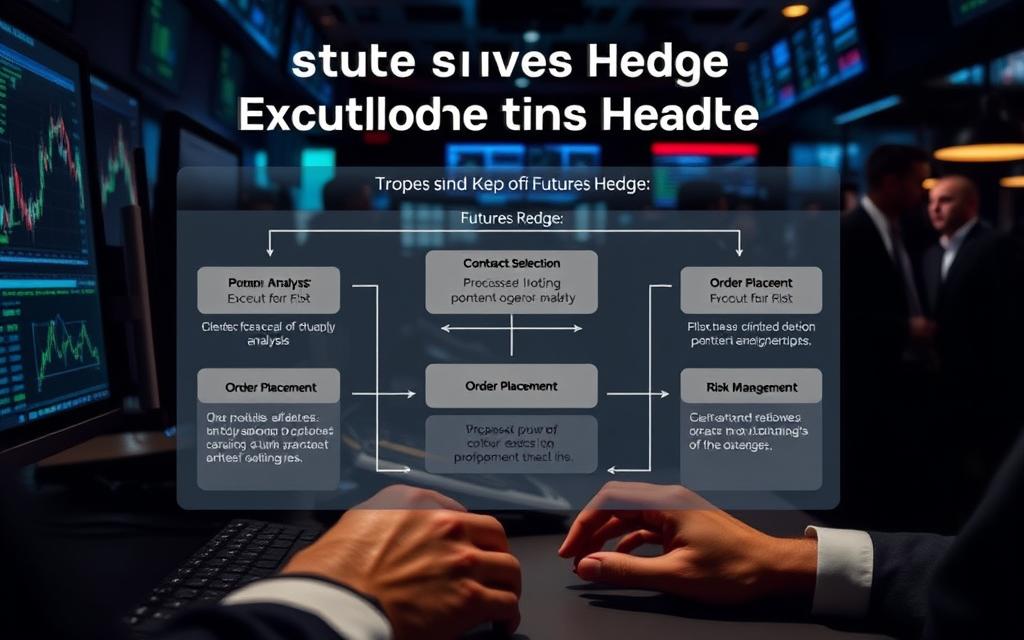Table of Contents
Digital assets like Bitcoin experience extreme price movements, often swinging 10% or more in a single day. This volatility creates risks for investors holding long-term positions. Fortunately, financial tools exist to manage exposure.
Perpetual futures offer a powerful solution. Unlike traditional contracts, they have no expiration dates, allowing flexible position management. Traders can offset potential losses in spot holdings by taking opposite positions in derivatives markets.
Consider protecting a $40,000 Bitcoin investment. Opening a short futures position equivalent to 1 BTC helps balance risk. If prices drop 15%, gains from the futures trade compensate for the spot portfolio’s decline. Proper leverage ratios (2x-10x) amplify this protection while requiring careful risk assessment.
Platforms like Mudrex simplify execution through automated tools. The key lies in precise position sizing and continuous monitoring. When used correctly, these instruments transform market turbulence into manageable scenarios.
What Is Hedging in Cryptocurrency Trading?
The concept of hedging traces back to ancient risk-mitigation practices. Derived from the Old English word hecg (boundary), it involves creating protective barriers around investments. Modern applications span stocks, commodities, and now digital assets.
Definition and Purpose of Hedging
Hedging offsets potential losses by taking opposite positions in related markets. For example, a $5,000 decline in Bitcoin’s spot value could be balanced by gains from a short futures contract. This strategy minimizes exposure without liquidating holdings.
Why Crypto Markets Need Hedging Strategies
Traditional markets close daily, but crypto trades 24/7 with extreme volatility. Miners and payment processors use hedging to stabilize revenue streams. Psychological benefits include reduced emotional decision-making during price swings.
Institutional adoption highlights its value. Corporate treasuries and mining operations employ these tactics to manage risk in unpredictable environments. Unlike traditional instruments, crypto hedging requires constant adjustment due to rapid price shifts.
Understanding Crypto Futures Contracts
Crypto futures offer unique advantages compared to traditional financial instruments. These contracts allow traders to speculate on price movements or protect existing holdings. Two primary types dominate the market: perpetual and fixed-maturity futures contracts.

Perpetual vs. Fixed-Maturity Futures
Perpetual crypto futures lack an expiration date, using funding rates to mirror spot prices. This design enables indefinite position holding. Fixed-maturity contracts, like CME Group’s quarterly BTC futures, expire on set dates.
- Funding rates: Perpetuals charge fees (e.g., 0.01% every 8 hours) to align with spot markets.
- Liquidation thresholds: Bybit’s 100x leverage demands tighter margin than CME’s 2x.
- Settlement: Binance uses USDT for cash settlements; Kraken supports physical delivery.
Key Mechanics: Leverage, Margin, and Settlement
Leverage amplifies exposure. A 2x position controls 2 BTC with 1 BTC collateral. However, higher ratios increase liquidation risks.
“CME’s BTC contracts are sized at 5 BTC per contract, while Bybit offers 0.001 BTC increments.”
Margin requirements vary by exchange. For example:
- Binance: 5% initial margin for 20x leverage.
- Kraken: 50% for 2x, favoring conservative traders.
Cash settlement (USDT/USDC) is common, but some platforms like Bakkt support physical BTC delivery.
How Do You Hedge Crypto with Futures? Core Strategies
Strategic risk management in digital asset portfolios requires precise hedging techniques. Futures contracts enable traders to offset volatility by locking in price levels or securing future purchase rates. These hedging strategies mirror tactics used in commodities, where oil producers and steel manufacturers stabilize revenues.
Short Hedge: Protecting Against Price Drops
A short hedge safeguards existing holdings. Imagine an oil producer locking in $100/barrel to avoid losses if spot prices fall. Similarly, a Bitcoin holder could short futures equivalent to their spot position. If BTC drops 20%, gains from the futures trade compensate.
Step-by-step P&L:
- Hold 1 BTC ($40,000) in your wallet.
- Open a short futures position for 1 BTC at $40,000.
- If BTC falls to $32,000, the futures gain $8,000, offsetting the spot loss.
Long Hedge: Mitigating Rising Asset Costs
A long hedge secures future purchase rates. A steel manufacturer might buy iron ore futures to fix costs at $60M annually. Crypto businesses use this to budget for token acquisitions. For example:
| Scenario | Action | Outcome |
|---|---|---|
| BTC rises 30% in 3 months | Long futures locked at $35,000 | Pay $35,000 instead of $45,500 |
| ETH doubles pre-launch | Pre-purchase via futures | Avoid 100% cost increase |
Basis risk—the gap between futures and spot prices—requires monitoring. Corporate treasuries often adjust hedge ratios quarterly to maintain alignment.
Step-by-Step Guide to Executing a Futures Hedge
Implementing a futures hedge requires careful planning and execution. This process involves three critical phases: selecting instruments, sizing positions, and ongoing adjustments. Each step ensures optimal protection against market swings.

Choosing the Right Contract and Exchange
Liquidity and security top the criteria for exchange selection. Platforms like Binance and Kraken offer deep order books, reducing slippage risks. Compare contracts using this framework:
| Feature | Perpetual Futures | Fixed-Maturity |
|---|---|---|
| Expiration | None | Quarterly/Monthly |
| Fees | Funding rates | Commission-based |
| Leverage | Up to 100x | 2x-5x (CME) |
“Dynamic hedging demands real-time data. Automated tools like Mudrex streamline this for retail traders.”
Calculating Hedge Ratio and Position Size
A 1:1 hedge ratio is common for Bitcoin portfolios. For 10 BTC ($400,000), short 10 BTC in futures. Adjust ratios for altcoins using portfolio beta:
- High-beta assets (e.g., SOL): Hedge 120% of spot value.
- Stablecoins: Exclude from hedging calculations.
Monitoring and Adjusting Your Hedge
Rebalance monthly or after 15% price moves. During the 2022 bear market, traders reduced leverage as volatility spiked. Key steps:
- Set price alerts for spot and futures markets.
- Review margin levels weekly to avoid liquidation.
- Adjust positions if funding rates exceed 0.05% daily.
Tax implications vary by jurisdiction. Frequent rebalancing may trigger short-term capital gains.
Risks and Costs of Hedging with Crypto Futures
The March 2020 market crash revealed critical vulnerabilities in leveraged positions. While futures contracts offer powerful protection, they introduce unique challenges that demand careful consideration. Understanding these trade-offs separates effective hedgers from those facing unexpected losses.

Basis Risk and Imperfect Hedges
Basis risk occurs when futures and spot prices diverge. During the LUNA collapse, perpetual contracts traded 12% below spot values for 48 hours. Traders quantify this gap using:
- Daily price deviation tracking
- 30-day correlation coefficients
- Rolling hedge effectiveness metrics
CME’s Bitcoin futures typically maintain 98% correlation with spot markets, while altcoin contracts often drop below 85% during volatility spikes.
Liquidation Risks and Leverage Pitfalls
A trader using 10x leverage on a $50,000 position faced $44,000 losses when ETH dropped 8.8% in May 2021. Key factors in liquidation cascades:
| Exchange | Liquidation Threshold | Insurance Fund |
|---|---|---|
| Binance | 80% margin ratio | $1.2B reserve |
| Bybit | 100% for 10x+ | Auto-deleveraging |
| FTX (pre-collapse) | 50% maintenance | None (counterparty risk) |
“The FTX implosion proved that exchange solvency matters as much as position sizing.” – Derivatives Analyst, Amberdata
Funding Rates and Trading Fees
March 2020 saw funding rates spike to 0.3% per 8 hours on BitMEX. This adds 3.6% weekly cost to maintain hedges. Fee comparisons:
- Binance: 0.04% taker fee + funding
- Deribit: 0.025% maker rebates
- Kraken: 0.02% for $10M+ volume
Smart traders arbitrage positive funding rates by going long on spot while shorting perpetuals.
Stress testing positions against historical volatility (like Bitcoin’s 30% single-day drops) helps optimize hedge ratios. Regulatory capital requirements vary by jurisdiction, with US traders facing stricter margin rules than offshore accounts.
Alternatives to Futures for Crypto Hedging
Sophisticated traders employ multiple instruments beyond futures to mitigate crypto volatility risks. While derivatives like perpetual contracts dominate hedging discussions, other products offer unique advantages for different market conditions. These alternatives range from options contracts to stablecoin-based strategies.
Seasoned investors often combine several approaches. This creates layered protection against both sudden crashes and prolonged bear markets. The choice depends on cost considerations, time horizons, and risk tolerance levels.
Options vs. Futures: Flexibility vs. Cost
Options provide asymmetric payoff structures unavailable in futures markets. A $5,000 put option might protect a $50,000 Bitcoin position with limited downside. Key differences emerge in premium costs and execution flexibility:
| Factor | Options | Futures |
|---|---|---|
| Upfront Cost | Premium (2-15% of notional) | Margin (5-50% of notional) |
| Profit Potential | Unlimited (long calls) | Linear to spot movement |
| Time Sensitivity | Expiration-dependent | Perpetual available |

DeFi protocols like Hegic automate options strategies through smart contracts. Collateralized put spreads can reduce premium costs by 40-60% compared to naked options. The Greeks—particularly delta and vega—help quantify position sensitivity to price and volatility changes.
Stablecoins and Diversification
During the 2022 bear market, USDC and TUSD allocations yielded 4-8% APY while preserving capital. This dual benefit makes stablecoins foundational for defensive strategies. Effective approaches include:
- Rotating 20-30% of portfolios into yield-bearing assets during high volatility periods
- Using cross-chain diversification to mitigate single-network risks
- Allocating to volatility index products when fear gauges spike
Tax-efficient vehicles like trusts can enhance after-tax returns on these positions. Unlike futures, stablecoin strategies require minimal monitoring while providing continuous downside protection.
Conclusion: Mastering Crypto Hedging for Long-Term Success
Financial innovation continues to reshape risk management tools. The 2024 regulatory landscape favors structured derivatives, with institutional holdings now exceeding $150B in crypto derivatives.
Projected market growth to $250B highlights expanding opportunities. ETF integrations and DeFi derivatives emerge as transformative forces for crypto portfolios.
Successful traders combine futures with options and stablecoins. These layered strategies adapt to volatility while preserving capital. Continuous education remains vital as instruments evolve.
Benchmark performance against institutional standards. Prioritize compliance and multi-tool approaches for sustainable results in dynamic markets.
FAQ
What is hedging in cryptocurrency trading?
Hedging reduces risk by opening offsetting positions. Traders protect their assets from adverse price movements while maintaining exposure to potential gains.
Why use futures contracts for crypto hedging?
Futures provide leverage, liquidity, and standardized terms. They allow traders to lock in prices, minimizing volatility risks in spot markets.
What’s the difference between perpetual and fixed-maturity futures?
Perpetual contracts lack expiration dates but have funding fees. Fixed-maturity futures settle on a predetermined date, ideal for time-specific hedging strategies.
How does a short hedge protect against price drops?
Selling futures contracts offsets losses in a declining market. If the asset’s spot price falls, gains from the short position balance the downturn.
What is basis risk in futures hedging?
Basis risk arises when futures and spot prices don’t move in sync. This mismatch can lead to imperfect hedges, impacting expected outcomes.
Can stablecoins be used for hedging crypto?
Yes. Converting volatile assets into stablecoins avoids price swings. However, this method lacks profit potential from futures-based strategies.
What are the costs of hedging with crypto futures?
Trading fees, margin requirements, and funding rates apply. Over-leveraging may trigger liquidations, amplifying risks despite the hedge.
How do traders calculate the optimal hedge ratio?
The ratio compares position sizes in futures and spot markets. It’s based on historical price correlations to ensure effective risk coverage.









